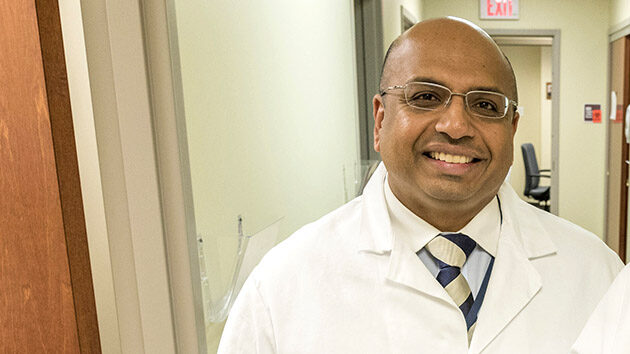Structural Heart Program Allows Care Tailored to Each Patient

Collaboration is key for the Structural Heart Program at Albany Medical Center. Cardiac physicians, cardiac surgeons, and interventional cardiologists analyze each patient’s specific condition, review imaging, and come together to consider the appropriate treatment plan for that patient.
“Conventionally, valve disease has been treated by separate specialties,” said Sanjay Samy, MD, professor of surgery, Alley Sheridan Chair in Cardiothoracic Surgery and Chief of the Division of Cardiothoracic Surgery. “But with improvements in technology and devices, we can now work as a team to get patients the best option for their valvular heart disease.”
Valve problems can be congenital, where patients are born with the issue, or a result of other life events, such as a heart attack, radiation therapy, blood infection, or even just aging. “The older you get, the higher the incidence of having valvular problems,” Dr. Samy said.
Patients usually seek care when they begin to experience shortness of breath, fatigue, or a lack of ability to do the activities that they used to normally do. Their doctor hears a murmur, orders an echocardiogram, and soon the patient is referred to the Valve Clinic.
The Valve Clinic is multidisciplinary, with the physicians doing a concurrent evaluation of the patient to determine the best approach to therapy.
“Traditionally, when you had valvular heart disease or problems with the valve, the treatment was surgery—opening the breastbone, using a heart-lung machine, and replacing the valve with either a bioprosthetic or mechanical heart valve,” Dr. Samy said. As technology has improved, doctors can now treat many structural heart issues through minimally invasive or catheter-based therapies via an artery in the groin.
Over the last 10-15 years, the number of patients receiving these less-invasive treatments, such as transcatheter aortic valve replacement (TAVR) or mitral valve repair procedures, has grown.
Albany Medical Center doctors are collecting data on which patients do better with one approach over another.
“There are certain subsets of patients who are too high risk for an open-heart surgical procedure, but healthy enough for a TAVR procedure or those who definitely would do better with a surgical valve replacement,” said Dr. Samy, a fellowship-trained cardiothoracic surgeon drawn to Albany Medical Center because of the partnership with interventional cardiology and cardiology. When evaluating which treatment to recommend, the medical team uses a measurement of mortality. These are based on assessments made in the clinic, co-morbidities, medical conditions, and other heart disease. For example, he added, “Younger patients sometimes will benefit from a mechanical valve which has a higher rate of durability.”
Albany Medical Center sees a higher volume of structural heart patients than other local institutions and is able to offer a significant amount of treatments for structural heart issues: TAVR, ASD repair, mitral valve disease with mitral valve clips, mitral replacement, left atrial appendage closure, and other minimally invasive and traditional heart valve replacements.
As an academic health system, Albany Medical Center is also training the next generation of cardiologists and cardiothoracic surgeons through its residency and fellowship programs.
“We make sure the residents and fellows have access to these new technologies,” Dr. Samy said. “They work with us. They are present in our valve clinics. They are in the assessment of these patients and seeing which would benefit.”
Clinical research of structural heart disease is active and evolving, allowing the program at Albany Medical Center to expand. He said, “We are constantly advancing our techniques and there’s constantly improvement in the technology itself.”